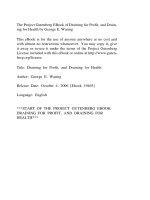Optical Interferometry for Biology and Medicine docx
Bạn đang xem bản rút gọn của tài liệu. Xem và tải ngay bản đầy đủ của tài liệu tại đây (9.75 MB, 367 trang )
Bioanalysis
For further volumes:
/>David D. Nolte
Optical Interferometry
for Biology and Medicine
David D. Nolte
Department of Physics
Purdue University
West Lafayette, IN, USA
ISBN 978-1-4614-0889-5 e-ISBN 978-1-4614-0890-1
DOI 10.1007/978-1-4614-0890-1
Springer New York Dordrecht Heidelberg London
Library of Congress Control Number: 2011940315
# Springer Science+Business Media, LLC 2012
All rights reserved. This work may not be translated or copied in whole or in part without the written
permission of the publisher (Springer Science+Business Media, LLC, 233 Spring Street, New York,
NY 10013, USA), except for brief excerpts in connection with reviews or scholarly analysis. Use in
connection with any form of information storage and retrieval, electronic adaptation, computer software,
or by similar or dissimilar methodology now known or hereafter developed is forbidden.
The use in this publication of trade names, trademarks, service marks, and similar terms, even if
they are not identified as such, is not to be taken as an expression of opinion as to whether or not they
are subject to proprietary rights.
Printed on acid-free paper
Springer is part of Springer Science+Business Media (www.springer.com)
Preface
Light is at once the most sensitive and the most gentle probe of matter. It is
commonplace to use light to measure a picometer displacement far below the
nanometer scale of atoms, or to capture the emission of a single photon from a
fluorescent dye molecule. Light is easy to generate using light-emitting diodes or
lasers, and to detect using ultrasensitive photodetectors as well as the now ubiquitous
digital camera . Light also has the uncanny ability to penetrate living tissue harm-
lessly and deeply, while capturing valuable information on the health and function of
cells. For these reasons, light has become an indispensible tool for biology and
medicine. We all bear witness to the central role of light in microscopi c imaging, in
optical biosensors and in laser therapy and surgery.
Interferometry, applied to biology and medicine, provides unique quantitative
metrology capabilities. The wavelength of light is like a meterstick against which
small changes in length (or phase) are measured. This meterstick analogy is apt,
because one micron is to one meter as one picometer is to one micron – at a dynamic
range of a million to one. Indeed, a picometer is detected routinely using interferom-
etry at wavelengths around one micron. This level of interferometric sensitivity
has great utility in many biological applications, providing molecular sensitivity
for biosensors as well as depth-gating capabilities to opticall y section living
tissue.
Optical Interferometry for Biology and Medicine presents the physical principles
of optical interferometry and describes their application to biological and medical
problems. It is divided into four sections. The first provides the underlying physics
of interferometry with complete mathematical derivations at the level of a junior
undergraduate student. The basics of interferometry, light scattering and diffraction
are presented first, followed by a chapter on speckle that gives the background for
this important phenomenon in biological optics – virtually any light passing
through tissue or cells becomes “mottled.” Although it presents a challenge to
imaging, speckle provides a way to extract statistical information about the condi-
tions of cells and tissues. Surface optics is given a chapter to itself because of the
central role played by surfaces in many optical biosensors and their applications.
v
The next three sections of the book discuss specific applications, beginning with
interferometric biosensors, then interferometric microscopy followed by interfero-
metric techniques for bulk tissues. Interferometric biosensors are comprised of
many different forms, including thin films, waveguides, optical resonators and
diffraction gratings. Microscopy benefits especially from interferometry because
layers of two-dimensi onal cells on plates can be probed with very high sensitivity to
measure subtle differences in refractive index of cells and their constituents.
Quantitative phase microscopy has become possible recently through application
of interferometric principles to microscopy. As cell layers thicken into tissues,
imaging becomes more challenging, but coherent techniques like optical coherence
tomography (OCT) and digital holography (DH) are able to extract information up
to 1 mm deep inside tissue.
While the principles of interferometry are universal, this book seeks always to
place them in the context of biological problems and systems. A central role is
played by the optical properties of biomolecules, and by the optical properties of the
parts of the cell. The structure and dynamics of the cell are also key players in many
optical experiments. For these reasons, there are chapters devoted explicity to
biological optics, including a chapter on cellular structure and dynamics as well
as a chapter on the optical properties of tissues. Throughout the book, biological
examples give the reader an opport unity to gain an intuitive feel for interference
phenomena and their general magnitudes. It is my hope that this book will be a
valuable resource for student and expert alike as they pursue research in optical
problems in biology and medicine.
I would like to thank my current students Ran An, Karen Hayrapetyan and Hao
Sun for proofreading the final manuscript, and much of this book is based on the
excellent work of my former students Manoj Varma, Kwan Jeong, Leilei Peng,
Ming Zhao and Xuefeng Wang. My colleagues Ken Ritchie, Brian Todd and Anant
Ramdas at Purdue University provided many helpful insights as the book came
together into preliminary form. Finally, I give my heartfelt appreciation to my wife
Laura and son Nicholas for giving me the time, all those Saturday mornings, to do
my “hobby.”
West Lafayette, IN, USA David D. Nolte
vi Preface
Contents
Part I Fundamentals of Biological Optics
1 Interferometry 3
1.1 Two-Wave Interference 3
1.1.1 Complex-Plane Representation of Plane Waves 3
1.1.2 Two-Port Interferometer 7
1.1.3 Homodyne Phase Quadrature 11
1.1.4 Heterodyne and Beats 12
1.1.5 Noise and Detection 13
1.1.6 Sub-nanometer Noise-Equivalent Displacement 16
1.2 Interferometer Configuration Classes 17
1.2.1 Wavefront-Splitting Interferometers:
Young’s Double Slit 17
1.2.2 Amplitude-Splitting Interferometers. 20
1.2.3 Common-Path Interferometers 26
1.3 Holography 29
1.3.1 Holographic Gratings 30
1.3.2 Image Reconstruction 32
1.3.3 Image-Domain or Fourier-Domain Holography 33
1.4 Coherence 35
1.5 Spectral Interferometry 36
1.5.1 Non-transform-Limited Pulses: Broadening 39
1.6 Interferometry and Autocorrelation 39
1.7 Intensity–Intensity Interferometry 43
1.7.1 Degree of Coherence 45
1.7.2 Hanbury Brown–Twiss Interferometry 45
Selected Bibliography 47
References . 47
vii
2 Diffraction and Light Scattering 49
2.1 Diffraction 50
2.1.1 Scalar Diffraction Theory 50
2.1.2 Fraunhofer Diffraction from Apertures and Gratings 53
2.1.3 Linear vs. Quadratic Response and Detectability 61
2.2 Fourier Optics 64
2.2.1 Fresnel Diffraction 66
2.2.2 Optical Fourier Transforms 67
2.2.3 Gaussian Beam Optics 69
2.3 Dipoles and Rayleigh Scattering 71
2.4 Refractive Index of a Dilute Molecular Film. 75
2.4.1 Phase Shift of a Single Molecule
in a Focused Gaussian Beam 76
2.4.2 Phase Shift from a Dilute Collection of Molecules 78
2.5 Local Fields and Effective Medium Approaches 79
2.5.1 Local Fields and Depolarization 79
2.5.2 Effective Medium Models 80
2.6 Mie Scattering 83
2.6.1 Spherical Particles 83
2.6.2 Effective Refractive Index
of a Dilute Plane of Particles 85
2.7 Nanoparticle Light-Scattering 87
2.7.1 Quantum Dots 88
2.7.2 Gold and Silver Nanoparticles 89
Selected Bibliography 94
References . 94
3 Speckle and Spatial Coherence 95
3.1 Random Fields 96
3.2 Dynamic Light Scattering (DLS) 99
3.2.1 Heterodyne: Field-Based Detection 101
3.2.2 Homodyne: Intensity-Based Detection 103
3.2.3 Fluctuation Power Sp ectra:
Wiener-Khinchin Theorem 104
3.3 Statistical Optics 106
3.4 Spatial Coherence 108
3.4.1 Autocorrelation Function and Power Spectrum 108
3.4.2 Coherence Area 112
3.5 Speckle Holography 114
3.6 Caustics 115
Selected Bibliography 120
References . 120
viii Contents
4 Surface Optics 123
4.1 Reflection from Planar Surfaces 123
4.2 Reflectometry of Molecules and Particles 128
4.2.1 Molecules on Surfaces 129
4.2.2 Particles on Surfaces 132
4.3 Surface Films 134
4.3.1 Transfer Matrix 136
4.3.2 Biolayers on a Substrate 137
4.4 Surface Plasmons 140
4.4.1 Planar Gold Films 140
4.4.2 Plasmon Polariton Coupling 143
Selected Bibliography 145
References . 145
Part II Molecular Interferometry and Biosensors
5 Interferometric Thin-Film Optical Biosensors 149
5.1 Label-Free Optical Biosensors and Direct Detection 150
5.2 Ellipsometric Biosensors 151
5.2.1 Experimental Ellipsometry on Biolayers 151
5.2.2 Interferometric Ellipsometry on Biolayers 154
5.3 Thin-Film Colorimetric Biosensors 156
5.4 Molecular Interferometric Imaging 158
5.4.1 In-line Quadrature 159
5.4.2 Image Shearing and Molecular Sensitivity 162
5.4.3 Biosensor Applications 165
5.5 The BioCD 167
5.5.1 Spinning Interferometric Biochips 167
5.5.2 Molecular Sensitivity, Sampling, and Scaling 170
Selected Bibliography 174
References . 174
6 Diffraction-Based Interferometric Biosensors 177
6.1 Planar Diffractive Biosensors 177
6.1.1 Diffraction Efficiency of Biolayer Gratings 179
6.1.2 Differential Phase Contrast 182
6.2 Microstructure Diffraction 185
6.2.1 Micro-diffraction on Compact Disks . 185
6.2.2 Micro-Cantilevers 189
6.3 Bead-Based Diffraction Gratings 192
References . 194
Contents ix
7 Interferometric Waveguide Sensors 197
7.1 Evanescent Confinement 197
7.1.1 Total Internal Reflection (TIR) 198
7.1.2 Dielectric Waveguide Modes 200
7.2 Waveguide Couplers 206
7.3 Waveguide Structures 208
7.3.1 Antiresonant Waveguide (ARROW) . 209
7.3.2 The Resonant Mirror 210
7.4 Mach–Zehnder Interferometric Waveguide Sensors 211
7.5 Young’s-Type Fringe-Shifting Interferometers 213
7.6 Guided-Mode Resonance (GMR) Sensors 214
7.7 Optofluidic Biosensors 217
7.8 Ring and Microdisk Resonators 219
7.9 Photonic-Bandgap Biosensors 220
References . 222
Part III Cellular Interferometry
8 Cell Structure and Dynamics 227
8.1 Organization of the Cell 227
8.2 Optical Properties of Cellular Components . . 229
8.3 The Cytoskeleton 230
8.4 Cellular Mechanics 231
8.4.1 Brownian Motion 232
8.4.2 Anomalous Diffusion 234
8.4.3 Cell Rheology 237
8.4.4 Generalized Stokes-Einstein Relation 238
8.5 Active Intracellular Motion 240
8.5.1 Microrheology Far from Equilibrium. 240
8.6 Membrane Mechanics 243
Selected Bibliography 248
References . 248
9 Interference Microscopy 251
9.1 Phase-Contrast Microscopy 251
9.2 Differential Interference Contrast 255
9.3 Particle Tracking Interferometry 257
9.3.1 Back Focal-Plane Interferometry 257
9.3.2 DIC Displacement Measurement 260
9.4 Reflection Interference Contrast Microscopy. 262
9.5 Fluorescence Interference Contrast Microscopy 264
9.6 Angular Scanning Interferometry 265
9.7 Broad-Field Interference Microscopy 266
9.8 Digital Holographic Microscopy 268
References . 271
x Contents
Part IV Interferometry of Biological Tissues
10 Light Propagation in Tissue 275
10.1 Origins of Light Scattering in Tissue 276
10.1.1 Scattering Phase Functions 277
10.1.2 Henyey–Greenstein Phase Function 281
10.1.3 Absorption, Scattering, and Extinction 281
10.2 Photon Transport 283
10.2.1 Diffuse Surface Reflectance 286
10.3 Enhanced Backscattering 288
10.4 Multiple Dynamic Light Scattering 291
10.4.1 Diffusing Wave Spectroscopy 291
Selected Bibliography 293
11 Optical Coherence Tomography 297
11.1 Coherence Gating 297
11.2 Time-Domain OCT 299
11.3 Fourier-Domain OCT 302
11.3.1 Spectral-Domain OCT 303
11.3.2 Swept-Source and In-Line OCT. . . 304
References . 305
12 Holography of Tissues 307
12.1 Dynamic Holography 308
12.1.1 Photorefractive Holography 308
12.1.2 Holographic Coherence-Gating . 310
12.1.3 Multicellular Tumor Spheroids 312
12.1.4 Photorefractive Optical Coherence Imaging 314
12.1.5 Phase-Conjugate Imaging 316
12.2 Digital Holography 319
12.2.1 Free-Space Propagation 319
12.2.2 Phase Extraction 321
12.3 Motility Contrast Imaging and Tissue Dynamics Spectroscopy . 326
12.3.1 Motility Contrast Imaging 327
12.3.2 Tissue Dynamics Spectroscopy (TDS) 329
References . 330
13 Appendix: Mathematical Formulas 335
13.1 Gaussian Integrals 335
13.2 Gaussian Beams 336
13.3 Fourier Transforms 337
13.3.1 Autocorrelation Relationships 337
Contents xi
13.4 Gaussian Pulses 338
13.5 Error Function 339
13.6 Gaussian Diffusion 339
13.7 Probability Distribution Generation 340
13.8 Trigonometric Identities 340
Index 343
xii Contents
Part I
Fundamentals of Biological Optics
sdfsdf
Chapter 1
Interferometry
All optical phenomena experience interference effects at some level. Even light
from an incandescent light bulb has partial coherence that can lead to constructive
or destructive interference when multiple light paths are combined at a detector.
The u biquitous nature of interference underlies many p henomena and techniques in
biological optics. This chapter lays the foundation for interferometry applied to
biology and medicine. It begins with the simplest form of interference between two
waves, explains common forms of interferometers, and ends with a short overview
of partial coherence and of higher-order interference effects.
1.1 Two-Wave Interference
The simplest interference involves two independent waves that have the same
frequency. This simplest case is also the one most commonly used in applications,
in which one wave carries phase information that is compared against a stable
reference wave. Phase cannot be detected directly by a detector. Two-wave inter-
ference provides a direct way to convert phase to detectable intensity.
1.1.1 Complex-Plane Representation of Plane Waves
Wave phenomena are conveniently represe nted in the complex plane, shown in
Fig. 1.1, as a real-valued amplitude r and a phase angle y
z ¼ r e
iy
(1.1)
D.D. Nolte, Optical Interferometry for Biology and Medicine, Bioanalysis 1,
DOI 10.1007/978-1-4614-0890-1_1,
#
Springer Science+Business Media, LLC 2012
3
The graphical representation of a complex number plots the real part along the
x-axis and the imaginary part along the y-axis using Euler’s formula to separate a
complex exponential into a real and an imaginary part as
r e
iy
¼ rðcos y þ i sin yÞ (1.2)
The complex representation of a plane wave propagating along the z-axis is
E ¼
~
A expðiðkz otÞÞ (1.3)
where
~
A ¼ A
jj
e
if
(1.4)
is the complex amplitude with static phase f, and the dynamical phase of the wave
is the dynamic quantity ðkz otÞ. For a plane wave propagating in the z direction,
the phase of the wave evolves according to the conven tion
y ¼ kz ot þ f (1.5)
where k ¼ 2p/l is the “wavenumber” with wavelength l, o is the angular fre-
quency of the wave, and f is a fixed (or slowly varying) phase. The wavenumber k
describes the spatial frequency, while o describes the angular frequency of the
wave. These two frequencies are linked to the wave velocity c by
o ¼ ck (1.6)
Fig. 1.1 Representation of a complex number z ¼ x þ iy on the complex plane. The x-axis is the
real part and the y-axis is the imaginary part
4 1 Interferometry
When a wave is represented graphically on the complex plane, it is called a “phasor.”
A phasor graphical construction is shown in Fig. 1.2. The phasor, which represents
the state of a wave, rotates counter-clockwise as the wave travels an increasing
distance, and clockwise with increasing time.
When two fields of the same frequency are added, the resultant is a wave with the
same spatial and temporal frequencies
A
1
expðiðkz ot þ f
1
ÞÞ þ A
2
expðiðkz ot þ f
2
ÞÞ
¼ A
1
expði f
1
ÞþA
2
expði f
2
Þ½expðiðkz otÞÞ
¼ Ajjexpði fÞexpðiðkz otÞÞ (1.7)
where the net amplitude is
A
jj
¼
ffiffiffiffiffiffiffiffiffiffiffiffiffiffiffiffiffiffiffiffiffiffiffiffiffiffiffiffiffiffiffiffiffiffiffiffiffiffiffiffiffiffiffiffiffiffiffiffiffiffiffiffiffiffiffiffiffiffiffiffiffiffi
A
2
1
þ A
2
2
þ 2A
1
A
2
cosðf
1
f
2
Þ
q
(1.8)
and the new phase is
f ¼ tan
1
A
1
sin f
1
þ A
2
sin f
2
A
1
cos f
1
þ A
2
cos f
2
(1.9)
Fig. 1.2 Phasor diagram of the complex amplitude of a plane wave. The phasor rotates counter-
clockwise with increasing distance, and clockwise with increasing time
1.1 Two-Wave Interference 5
Phasor addition is shown graphically in Fig. 1.3 for two waves with the same
frequencies. The net phasor A
T
rotates at the same rate as the individual phasors.
Intensities in a homogeneous dielectric medium are related to electric fields through
I ¼ e
m
e
0
v E
2
¼ n
m
ce
0
E
2
(1.10)
where e
m
is the dielectric constant of the medium, v ¼ c/n
m
is the wave speed of the
medium with a refractive index n
m
¼
ffiffiffiffiffi
e
m
p
, and the brackets denote a time average.
Often in this book the proportionality between intensity and squared field is set
conveniently to unity as I ¼ A
jj
2
. The detected intensity of the resultant is then
expressed as
I ¼ A
1
expði f
1
ÞþA
2
expði f
2
Þ
jj
2
¼ A
2
1
þ A
2
2
þ A
1
A
2
expðiðf
1
f
2
ÞÞ þ A
1
A
2
expðiðf
2
f
1
ÞÞ
¼ A
2
1
þ A
2
2
þ 2A
1
A
2
cosðf
1
f
2
Þ¼I
1
þ I
2
þ 2
ffiffiffiffiffiffiffiffi
I
1
I
2
p
cosðf
1
f
2
Þ (1.11)
The resultant intensity is a function of the two intensities and of the relative phase
difference between the fields.
It is common to define an interferometric response function that is normalized by
the total input intensity as
R ¼ 1 þ 2
ffiffiffiffiffiffiffiffi
I
1
I
2
p
ðI
1
þ I
2
Þ
cosðf
1
f
2
Þ¼1 þ 2
ffiffiffi
b
p
1 þ b
cosðf
1
f
2
Þ (1.12)
Fig. 1.3 Addition of phasors on the complex plane. If the waves have the same frequency, then
the resultant A
T
also rotates at that frequency
6 1 Interferometry
where the ratio of intensities is b ¼ I
1
/I
2
.WhenI
1
¼ I
2
, there is perfect
constructive interference and perfect destructive interference for the appropriate
relative phases. The graph of the response function is shown in Fig. 1.4 for several
beam ratios.
Contrast is an important property of interference. The contrast is defined as
Fringe contrast:
CðbÞ¼2
ffiffiffiffiffiffiffiffi
I
1
I
2
p
ðI
1
þ I
2
Þ
¼ 2
ffiffiffi
b
p
1 þ b
(1.13)
Contrast is plotted in Fig. 1.5 as a function of beam ratio b on both a linear and a log
scale. Even when the beam intensity ratio is over a thousand to one, there is still a 6%
contrast, because the square-root dependence in the numerator partially compensates
the denominator. The slow dependence of contrast on beam ratio is the reason why
interference effects can be relatively strong even when one of the interfering fields is
very weak. This allows interference effects to persist even in high-background
conditions that are common in biomedical applications that have strong light scatter-
ing backgrounds.
1.1.2 Two-Port Interferometer
The simplest way to combine two waves is with a beam splitter, shown in Fig. 1.6.
Two waves are incident on opposite input ports of a beamsplitter, and each are
Fig. 1.4 The interferometric response curve as a function of relative phase for a selection of beam
intensity ratios. The interference contrast is C ¼ 1, 0.8, 0.47, 0.25, 0.12 and 0.062 for b ¼1, 4, 16,
64, 256 and 1,024, respectively
1.1 Two-Wave Interference 7
combined with the other in the two outputs. The output intensities share the total
input energy, but the intensities depend on the relative phase between the two
input beams.
The two electromagnetic waves incident on a beamsplitter are
E
s
¼ E
s
0
expði kx i ot þ f
s
Þ
E
r
¼ E
r
0
expði kx i ot þ f
r
Þ (1.14)
Fig. 1.5 Interference contrast as a function of beam ratio b ¼ I
1
/I
2
. The log–log plot shows the
slope of ½ which gives a weak dependence on b
8 1 Interferometry
If each wave is split equally by the beamsplitter (50/50 beamsplitter), the two
output ports have the fields
E
1
¼
E
0
s
ffiffiffi
2
p
expði kx i ot þ f
s
Þþ
E
0
r
ffiffiffi
2
p
expði kx i ot þ f
r
Þ
E
2
¼
E
r
0
ffiffiffi
2
p
expði kx i ot þ f
r
Þ
E
0
r
ffiffiffi
2
p
expði kx i ot þ f
r
Þ (1.15)
The transformation by the beamsplitter can be expressed in matrix form as
E
out
¼ BE
in
E
1
E
2
¼
B
11
B
12
B
21
B
22
E
s
E
r
(1.16)
in which the beamsplitter matrix B is a unitary operator that creates the coherent
superposition of the input waves at the output ports in a way that conserves total
intensity (energy). For a 50/50 beamsplitter
B ¼
B
11
B
12
B
21
B
22
¼
1
ffiffiffi
2
p
11
11
(1.17)
Fig. 1.6 Beam combination by a beamsplitter. A phase-modulated signal wave and a stable
reference wave are incident on opposite input ports. Superposed waves exit the two output
ports. The total energy exiting the beamsplitter equals the total energy incident on the beamsplitter.
However, the relative intensities that exit each port depend on the phase difference between the
two input waves
1.1 Two-Wave Interference 9
The measured intensities at the outputs includes the interfering cross terms
between the fields, and are
I
1;2
¼
E
0
s
ffiffiffi
2
p
2
þ
E
0
r
ffiffiffi
2
p
2
E
0
r
E
0
s
2
expðiðf
r
f
s
ÞÞ
E
0
r
E
0
s
2
expðiðf
s
f
r
ÞÞ
¼
1
2
I
s
þ I
r
2
ffiffiffiffiffiffiffi
I
s
I
r
p
cosðf
r
f
s
Þ
ÂÃ
(1.18)
These conserve total intensity, but the intensity switches back and forth between the
two ports as the relative phase ðf
r
f
s
Þ changes. The response curve of a 50/50
beam-combiner is
R ¼ 1
2
ffiffiffiffiffiffiffi
I
s
I
r
p
I
s
þ I
r
cosðf
r
f
s
Þ¼1 CðbÞcosðf
r
f
s
Þ (1.19)
which is shown in Fig. 1.7.
There are two common nomenclatures for interferometry known as homodyne or
heterodyne detection. These terms can mean somewhat different things, depending
on how the interferometry is being performed. In a two-port interferometer,
homodyne relates to a signal and reference waves that both have the same frequency
and have a stable relative phase (but with a small phase modulation). On the
other hand, heterodyne relates to the case where there is a frequency offset between
the waves, or equivalently, if there is a large time-varying phase offset between the
waves. These two terms homodyne or heterodyne are also used for light scattering
Fig. 1.7 Universal interferometric response curve for a two-mode interferometer. The total
energy is shared between the two outputs, with the relative intensities in each channel dependent
on the relative phase between the two waves
10 1 Interferometry
experiments where the meaning is different. When only scattered light is detected,
this is called homodyne detection. But if part of the original wave interferes with the
scattered light, even if it is at the same frequency, this is called heterodyne detection.
The different usages of these terms may lead to some confusion. However, the
context (interferometer vs. light scattering) usually makes it clear.
1.1.3 Homodyne Phase Quadrature
When the signal wave in a two-port interferometer under homodyne detection
carries a small time-dependent phase modulation f
s
ðtÞ¼f
0
þ DfðtÞ, interferom-
etry converts this phase modulation (which cannot be observed directly) into an
intensity modulation (that can be). The main question is, what relative phase
f
0
allows the maximum phase-to-intensity conversion? The most sensitive part of
the response curve in Fig. 1.7 to a small phase modulation is at the condition of
steepest slope. The slope of the response curve is called the interferometric
responsivity. For phase modulation, the responsivity R
f
is
Phase responsivity:
R
f
¼
dR
dDf
¼CðbÞsinðf
r
f
0
Þ
(1.20)
For a given small phase modulation amplitude Df , the intensity response to phase
modulation on the signal wave is
DI ¼ R
f
Df
s
(1.21)
The phase responsivity is maximum when the phase difference between the signal
and the reference is at 90
,orðf
r
f
0
Þ¼p/2. This is the condition known as
“phase quadrature.” The intensity modulation in phase quadrature is
DI ¼ CðbÞDf
s
(1.22)
and the largest intensity modulations are obtained in phase quadrature at a contrast
of unity.
The phasor diagram for homodyne quadrature detection of phase modulation on
a signal wave is shown in Fig. 1.8. The reference wave is drawn along the real axis,
and the signal wave is 90
out of phase (in phase quadrature) along the imaginary
axis. In a phasor diagram, phase modulation on a wave is represented as a small
phasor orthogonal to the carrier phasor. In this example, the phase modulation DE
s
is parallel to the real axis and hence is in phase with the reference wave E
r
.
Therefore, the phase modulation adds in-phase with the reference and is detected
as an intensity modulation.
1.1 Two-Wave Interference 11
1.1.4 Heterodyne and Beats
When there is a frequency difference between the two interfering waves, the
combined wave exhibits beats. This is demonstrated by adding tw o waves with
different frequencies. The relative phase between the waves changes linearly in
time, and the system moves continually in and out of phase. The total wave,
considering only the temporal part, is
E
Tot
¼ E
1
expðiðo
1
t þ a
1
ÞÞ þ E
2
expðiðo
2
t þ a
2
ÞÞ (1.23)
This is best rewritten in terms of the average frequencies and phases as
E
Tot
¼ expðiðo
m
t þ a
m
ÞÞ
E
1
expðiðDot þ DaÞÞ þ E
2
expðiðDot þ DaÞÞ½ (1.24)
where the average values and differences are
o
m
¼
1
2
ðo
1
þ o
2
Þ Do ¼
1
2
ðo
1
o
2
Þ
a
m
¼
1
2
ða
1
þ a
2
Þ Da ¼
1
2
ða
1
a
2
Þ
(1.25)
Fig. 1.8 Complex representation of phase quadrature. The phase modulated field DE
s
on the
signal wave is parallel to the reference wave E
r
to produce constructive interference
12 1 Interferometry









